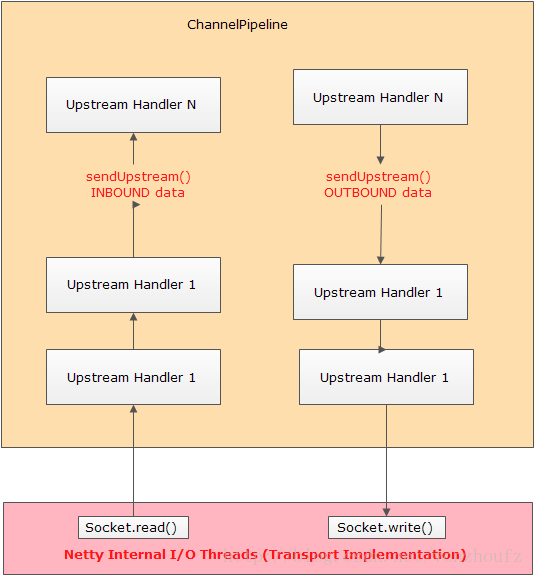Netty3 源码分析 - ChannelPipeline
ChannelPipeline的作用就是组织一系列的
ChannelHandlers
为某一个Channel服务,处理各种事件。实现了拦截过滤器模式的高级形式(
an advanced form of the Intercepting Filter pattern),进而有效控制如何处理一个事件以及
ChannelHandlers之间如何交互。类型结构图为:
流水线的创建:对于每个新的通道,必须为其创建和添置一个Pipeline,一旦设置,他们之间的耦合就是永久的,这个通道不同添置另一个流水线,不能解耦当前的Pipeline。创建Pipeline的推荐方式是利用Channels中的辅助方法,而不是调用某个实现的构造器。
import static org.jboss.netty.channel.Channels.*;
ChannelPipeline pipeline = pipeline(); // same with Channels.pipeline()
Pipeline中事件流动:下图展示了事件被各个
ChannelHandlers
处理的典型方式
. 一个ChannelEvent可以被ChannelUpstreamHandle或ChannelDownstreamHandler 处理而后通过调用
ChannelHandlerContext.sendUpstream(ChannelEvent) 或者
ChannelHandlerContext.sendDownstream(ChannelEvent) 把事件
转发到最近的一个Handler。根据事件的方向事件有不同的解释 (参见
ChannelEvent
)。
上行和下行事件分为被相应方向的Handler所处理。一个upstream handler通常处理由图中底部所示IO线程产生的带内数据(
inbound data
)。带内数据通常是真正的输入流从远端主机读到的数据,即 InputStream.read(byte[]).。如果一个上行事件到达了
upstream handler的最顶端,那么就会默默的丢弃。
与之类似,一个
downstream handler
产生和传输带外数据(
outbound traffic
)比如说写请求,如果一个下行事件到达了了最低端,就会被与这个Channel相关的IO线程所处理(就是之前说道的worker thread)。这里的IO线程通常执行真正的输出流操作,即
OutputStream.write(byte[])。
看下面这个pipeline:
ChannelPipeline p = Channels.pipeline();
p.addLast("1", new UpstreamHandlerA());
p.addLast("2", new UpstreamHandlerB());
p.addLast("3", new DownstreamHandlerA());
p.addLast("4", new DownstreamHandlerB());
p.addLast("5", new UpstreamHandlerX());
要注意的是,站在不同的方向Handler顺序的解读是不一样的,而且要看这个Handler的职责范围。比如对于
upstream event经过的Handler依次是1,2,5,对于downstream event经过的Handler顺序是4,3.
构建pipeline:我们可能会在程序中需要多个Handlers来处理IO请求如read,write,close等。比如说典型的服务器需要每个通道都有以下handlers,而且会取决于协议和业务罗杰的复杂度。
Protocol Decoder - translates binary data (e.g. ChannelBuffer) into a Java object.
Protocol Encoder - translates a Java object into binary data.
ExecutionHandler - applies a thread model.
Business Logic Handler - performs the actual business logic (e.g. database access).
代码形式像这样:
ChannelPipeline pipeline = Channels.pipeline();
pipeline.addLast("decoder", new MyProtocolDecoder());
pipeline.addLast("encoder", new MyProtocolEncoder());
pipeline.addLast("executor", new ExecutionHandler(
new OrderedMemoryAwareThreadPoolExecutor(16, 1048576, 1048576)));
pipeline.addLast("handler", new MyBusinessLogicHandler());
线程安全:因为
ChannelPipeline
是线程安全的,所以可以任何时刻可以将一个ChannelHandler加入或移除。比如,当出现敏感信息的时候加入
SslHandler,交易完成后移除它。
缺陷(Pitfall):由于现在默认
ChannelPipeline的内部实行细节,下面的代码不会如期工作,如果这里的
FirstHandler
也是该pipeline中最后一个Handler的话。(不知道现在的netty5怎么做的呢?)
public class FirstHandler extends SimpleChannelUpstreamHandler {
@Override
public void messageReceived(ChannelHandlerContext ctx, MessageEvent e) {
// Remove this handler from the pipeline,
ctx.getPipeline().remove(this);
// And let SecondHandler handle the current event.
ctx.getPipeline().addLast("2nd", new SecondHandler());
ctx.sendUpstream(e);
}
}
正确的做法是在移除前确保至少还有一个Handler(因为Handler context中的pre,next缘故?),或者先增加再移除。
详细的源码注释看我的 github。
